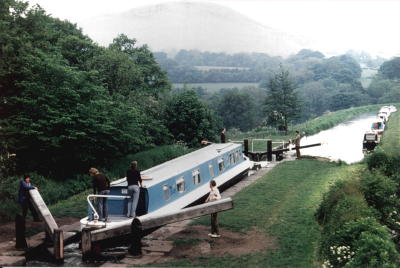Buglawton
Bosley to Buglawton (3½ miles)
 There are extensive and popular moorings at the bottom of Bosley locks. Half a mile from the nearest road, deep in the Dane valley, this is an extraordinarily tranquil place. The silence is interrupted for a few seconds every now and then by electric trains passing over the massive brick viaduct further down the valley. They look just like Dad's favourite toys! The River Dane is crossed by an elegant but none the less substantial stone aqueduct; just one arch. Notice the modern (1997) footbridge across the spillway just before Old Driving Lane Bridge, no. 57. There are extensive and popular moorings at the bottom of Bosley locks. Half a mile from the nearest road, deep in the Dane valley, this is an extraordinarily tranquil place. The silence is interrupted for a few seconds every now and then by electric trains passing over the massive brick viaduct further down the valley. They look just like Dad's favourite toys! The River Dane is crossed by an elegant but none the less substantial stone aqueduct; just one arch. Notice the modern (1997) footbridge across the spillway just before Old Driving Lane Bridge, no. 57.
The canal proceeds through a long and delightful rural section,
having very little contact with the rest of the world. This is the
one length where Crosley accepted the need to give in to the landscape
and follow round the hills and valleys*. As a result the canal makes
a big loop out to Buglawton then back up to Dane-in-Shaw and around
Congleton Hightown before resuming its southerly course. For the
first part of this The Cloud (the hill) lies brooding to the east.
Just beyond the railway viaduct we pass Crossley Hall, a fine Tudor
farm house. Old Driving Lane Bridge, no. 57 and Congleton Bridge,
no. 61, both provide good access to The Cloud for those with the
puff to climb those craggy heights.
From beyond Stannier’s 1st Bridge, no. 62 until Stanley’s Bridge, no. 65, the canal assumes that primordial feel, especially in the right weather conditions - it is heavily tree lined, offering drips after rain and shade on sunny days. This all changes once the turn is taken at Buglawton and the straight mile stretches out before us with its seven bridges in view.
Next: Congleton Hightown
* This comment relates to the fact that Thomas Telford originally
designed the route of the Macclesfield Canal to be more of a contour
canal. When William Crosley came to build it he made significant
changes to the route and cut almost two miles off Telford's route
by building bigger embankments and deeper cuttings. He also eliminated
two tunnels - one at Richmond Hill in Macclesfield which he openned
out, and the other at Ramsdell Hall where he avoided a shallow tunnel
behind the house probably by convincing the owner that building an
open canal in front of the house would enhance the beauty of his
garden and its outlook. |